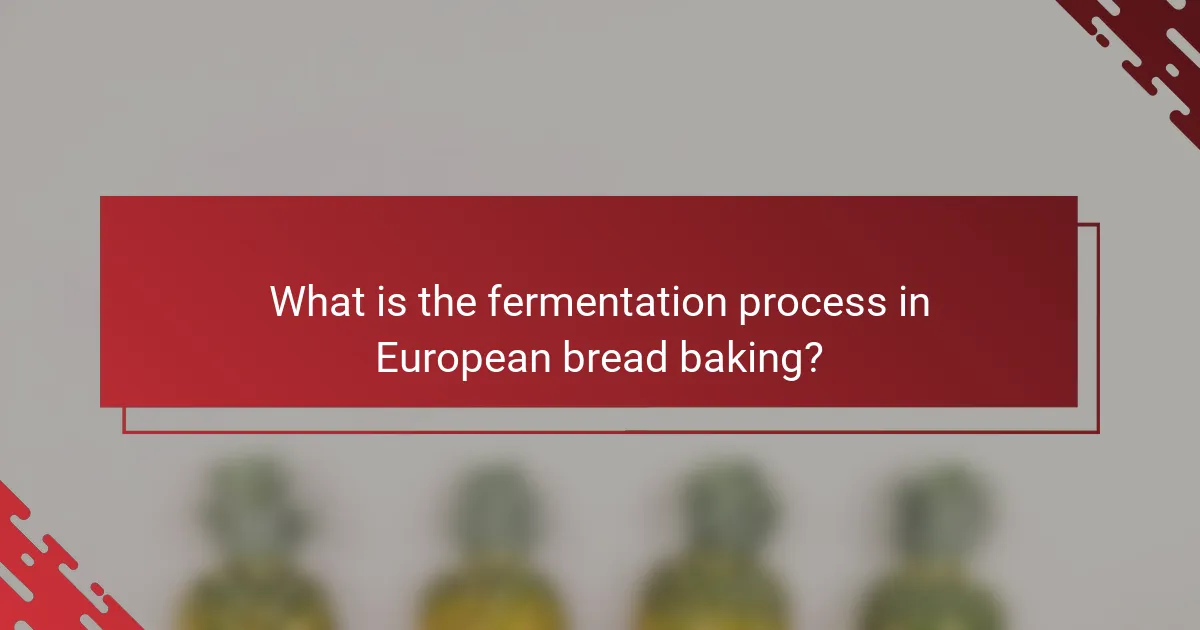European bread baking involves essential techniques such as fermentation, kneading, shaping, and baking, each contributing to the final product’s texture and flavor. The primary ingredients include flour, water, yeast, and salt, which play crucial roles in structure, hydration, leavening, and flavor enhancement. Fermentation, a key process in bread making, occurs in two stages—bulk fermentation and proofing—where yeast converts sugars into carbon dioxide, allowing the dough to rise. Temperature, humidity, and flour type significantly influence fermentation, impacting the overall quality of various European bread types, including baguettes and sourdough. Understanding these techniques and ingredients is vital for achieving the desired characteristics in European breads.

What are the key baking techniques for European breads?
The key baking techniques for European breads include fermentation, kneading, shaping, and baking. Fermentation allows yeast to develop flavors and leaven the dough. Kneading creates gluten, providing structure and elasticity. Shaping ensures the bread rises properly and maintains its form. Baking at high temperatures develops a crust and enhances flavor. Each technique is essential in achieving the desired texture and taste in European breads. For example, traditional French baguettes rely on a long fermentation process for flavor development.
How do different baking techniques influence the texture of bread?
Different baking techniques significantly influence the texture of bread. Techniques such as steaming, baking on a stone, and using different oven temperatures create distinct textures. Steaming during the initial baking phase produces a crispy crust. Baking on a stone retains heat, resulting in a chewy interior. Higher oven temperatures can create a lighter, airier crumb. Additionally, the duration of baking affects moisture levels, impacting the final texture. For instance, longer baking times can lead to a drier texture, while shorter times may yield a softer loaf. These variations are essential for achieving specific bread styles, such as French baguettes or Italian ciabatta.
What role does kneading play in developing gluten?
Kneading plays a crucial role in developing gluten. It physically manipulates the dough, aligning gluten strands. This alignment creates a network that traps gas produced during fermentation. The process enhances the dough’s elasticity and strength. Stronger gluten networks lead to better bread structure. Research shows that proper kneading can increase dough extensibility. This results in improved volume and texture in the final product.
How does shaping affect the final appearance of bread?
Shaping significantly influences the final appearance of bread. Proper shaping creates a uniform surface and ensures even expansion during baking. Different techniques, such as round or batard shaping, yield distinct visual outcomes. For instance, a round loaf has a smooth, rounded crust, while a batard has elongated sides. Additionally, shaping affects the crust’s texture and color. A well-shaped loaf promotes better oven spring, leading to a taller, more appealing bread. The final appearance is also impacted by the shaping technique used, which can enhance or detract from the bread’s overall aesthetic.
What types of European breads utilize unique baking techniques?
Sourdough, ciabatta, and baguette are types of European breads that utilize unique baking techniques. Sourdough employs a natural fermentation process using wild yeast and bacteria. This method enhances flavor and texture. Ciabatta features a high hydration dough, resulting in an open crumb structure. The dough is often shaped by hand rather than rolled. Baguette is distinguished by its long, thin shape and a crispy crust, achieved through steam baking. Each of these breads showcases distinct techniques that contribute to their unique characteristics.
Which breads are known for their crusty exterior?
Breads known for their crusty exterior include baguettes, ciabatta, and sourdough. Baguettes have a thin, crispy crust and a soft interior. Ciabatta features a rustic, chewy crust with an open crumb structure. Sourdough is characterized by its tangy flavor and thick, crunchy crust. These breads often utilize high hydration and steam during baking, contributing to their crusty texture. The baking process for these breads typically involves a preheated oven and sometimes a baking stone to enhance crust formation.
What are the characteristics of soft European breads?
Soft European breads are characterized by their light texture and moist crumb. They often have a thin, tender crust that enhances the overall softness. These breads typically use high-protein flour, which contributes to their structure and elasticity. A higher hydration level in the dough results in a softer crumb.
Fermentation plays a crucial role, with longer fermentation times allowing for better flavor and texture development. Ingredients such as milk, butter, or oil are commonly added to enrich the dough, further enhancing softness. Examples of soft European breads include brioche and pain de mie, both known for their delicate, fluffy qualities.

What ingredients are essential for European bread baking?
The essential ingredients for European bread baking are flour, water, yeast, and salt. Flour provides the structure and carbohydrates necessary for fermentation. Water hydrates the flour, activating gluten formation. Yeast is the leavening agent that causes the dough to rise. Salt enhances flavor and controls yeast activity. These ingredients are foundational across various European bread types, such as baguettes and sourdough. The balance and quality of these ingredients significantly impact the final bread product.
How do different flours impact the baking process?
Different flours impact the baking process by influencing texture, flavor, and structure. Each type of flour has a unique protein content. Higher protein flours, like bread flour, create more gluten. This results in a chewier texture and better rise in yeast breads. Lower protein flours, such as cake flour, yield a tender crumb. They are ideal for delicate baked goods. Whole wheat flour adds a nutty flavor and denser texture. It also absorbs more liquid, affecting hydration levels. The milling process also affects flour characteristics. For example, finely milled flour creates a smoother dough. Coarse flour may lead to a grainier texture. Understanding these differences is crucial for achieving desired results in baking.
What are the distinctions between bread flour and all-purpose flour?
Bread flour contains a higher protein content than all-purpose flour. Typically, bread flour has about 12-14% protein, while all-purpose flour has around 10-12%. This higher protein level in bread flour promotes gluten development. Gluten is essential for the structure and chewiness of bread. All-purpose flour is more versatile for various recipes but may yield softer baked goods. The distinct protein levels affect the texture and rise of the final product. Bread flour is ideal for yeast breads, while all-purpose flour suits a broader range of baking needs.
How does the protein content of flour affect dough development?
The protein content of flour significantly affects dough development. Higher protein levels lead to stronger gluten formation. Gluten provides elasticity and strength to the dough. This elasticity allows the dough to trap gases produced during fermentation. Consequently, a well-developed dough rises effectively, resulting in a better texture. For example, bread flour typically has 12-14% protein, ideal for yeast breads. In contrast, all-purpose flour contains about 10-12% protein, suitable for a variety of baked goods. The type of flour used directly influences the final product’s structure and crumb.
What role do yeast and fermentation play in bread making?
Yeast and fermentation are crucial in bread making. Yeast is a microorganism that ferments sugars, producing carbon dioxide and alcohol. This process causes the dough to rise, creating a light and airy texture. Fermentation also develops flavor and aroma in the bread. During fermentation, enzymes break down starches into sugars, which yeast then consumes. This interaction enhances the bread’s nutritional value. The fermentation time can vary, affecting the bread’s final taste and texture. Typically, longer fermentation leads to more complex flavors. This method has been used for thousands of years, highlighting its importance in traditional baking.
How does active dry yeast differ from fresh yeast?
Active dry yeast differs from fresh yeast primarily in its moisture content and storage requirements. Active dry yeast is dehydrated and has a longer shelf life. It requires rehydration in warm water before use. Fresh yeast, also known as cake yeast, contains more moisture and must be refrigerated. It has a shorter shelf life and is typically used directly in recipes. The potency of fresh yeast is generally higher, providing a faster fermentation process. In contrast, active dry yeast may take longer to activate due to its dehydrated state.
What are the effects of using sourdough starter compared to commercial yeast?
Using sourdough starter results in a different fermentation process compared to commercial yeast. Sourdough starter contains wild yeast and lactic acid bacteria, providing unique flavors and textures. This fermentation method often leads to a denser crumb and a more complex taste profile. In contrast, commercial yeast ferments quickly, producing a lighter texture and milder flavor.
The acidity from sourdough can enhance shelf life and improve digestibility. Studies show that sourdough fermentation increases bioavailability of nutrients. Additionally, sourdough can have lower glycemic index effects compared to bread made with commercial yeast. Overall, the choice between sourdough starter and commercial yeast significantly impacts the final bread characteristics.

What is the fermentation process in European bread baking?
The fermentation process in European bread baking involves the conversion of sugars into carbon dioxide and alcohol by yeast. This process is crucial for developing the bread’s flavor and texture. Yeast consumes the sugars present in the dough, producing carbon dioxide gas. The gas creates bubbles, causing the dough to rise.
Fermentation typically occurs in two stages: bulk fermentation and proofing. During bulk fermentation, the dough is allowed to rise after mixing. This stage can last several hours, depending on the recipe and temperature. Proofing is the final rise before baking, which usually lasts about 30 minutes to 1 hour.
The temperature and humidity can significantly impact fermentation. Warmer temperatures accelerate yeast activity, while cooler temperatures slow it down. Additionally, the type of flour used can affect the fermentation process. Bread flour, for example, has a higher protein content, which contributes to better gluten development.
Overall, fermentation is essential for achieving the desired characteristics in European bread, including its structure, flavor, and aroma.
How does fermentation contribute to flavor development?
Fermentation contributes to flavor development by transforming raw ingredients into complex flavor profiles. During fermentation, yeast and bacteria break down sugars into alcohol and organic acids. This process generates various volatile compounds that enhance aroma and taste. For example, lactic acid produced by bacteria adds tanginess to bread. Additionally, fermentation can increase the depth of flavor through the production of esters and phenols. The duration and conditions of fermentation also influence the final flavor. Longer fermentation times typically yield more pronounced flavors. Studies show that artisan breads with longer fermentation periods have richer taste profiles compared to those with shorter fermentation.
What are the stages of fermentation in bread dough?
The stages of fermentation in bread dough are bulk fermentation, shaping, and final proofing. Bulk fermentation is the initial stage where yeast ferments sugars, producing carbon dioxide and alcohol. This stage usually lasts from one to several hours, depending on the dough temperature and yeast activity. During bulk fermentation, the dough expands and develops gluten structure. Shaping follows, where the dough is formed into its final shape. This stage is crucial for creating surface tension. Final proofing occurs after shaping, allowing the dough to rise again briefly before baking. This stage enhances flavor and texture. Each stage is essential for achieving the desired bread characteristics.
How does fermentation time affect the final product?
Fermentation time significantly influences the flavor, texture, and overall quality of the final product. Longer fermentation allows for the development of more complex flavors due to the breakdown of sugars and production of organic acids. It enhances the bread’s texture by promoting gluten development, resulting in a chewier crumb. Additionally, extended fermentation can contribute to better shelf life by creating a more acidic environment that inhibits spoilage. Research indicates that bread fermented for longer periods often exhibits improved aroma and taste profiles. For instance, a study by the University of Copenhagen found that sourdough fermented for 12 hours had a more pronounced flavor compared to a 2-hour fermentation.
What techniques can enhance the fermentation process?
Techniques that can enhance the fermentation process include temperature control, proper hydration, and using starter cultures. Temperature control optimizes yeast activity. Ideal fermentation temperatures range from 75°F to 85°F. Proper hydration increases dough extensibility. A hydration level of 60% to 75% is often recommended. Using starter cultures introduces beneficial microorganisms. These cultures can improve flavor and texture. Additionally, bulk fermentation allows for better gluten development. This stage typically lasts 1 to 3 hours. Finally, incorporating stretch and fold techniques can strengthen the dough structure. These methods are supported by baking science and practical applications in artisan bread making.
How does temperature influence yeast activity during fermentation?
Temperature significantly influences yeast activity during fermentation. Yeast thrives within a specific temperature range, typically between 75°F to 85°F (24°C to 29°C). At these temperatures, yeast metabolizes sugars efficiently, producing carbon dioxide and alcohol. Lower temperatures slow down yeast activity, resulting in slower fermentation. Yeast can become dormant at temperatures below 50°F (10°C). Conversely, temperatures above 90°F (32°C) can stress yeast, leading to off-flavors and reduced fermentation efficiency. Optimal temperatures promote a balanced fermentation process, enhancing the flavor and texture of the bread.
What are the benefits of using autolyse in dough preparation?
Autolyse improves dough quality by enhancing gluten development and hydration. This process allows flour to absorb water without kneading. It leads to a more extensible and elastic dough. Autolyse also reduces mixing time, making the process more efficient. Additionally, it can improve the bread’s flavor and aroma. Studies show that autolyse can increase dough strength and gas retention. This results in better rise and texture in the final product. By using autolyse, bakers can achieve superior results in European bread making.
What tips can improve your European bread baking skills?
To improve your European bread baking skills, focus on using high-quality ingredients. Select bread flour with a high protein content for better gluten development. Hydration is crucial; aim for a dough moisture level between 60% to 75%. Knead the dough thoroughly to develop gluten, which gives bread its structure. Allow for proper fermentation; longer fermentation times enhance flavor and texture. Use a pre-ferment, like a poolish or biga, to improve taste and crust. Maintain a consistent baking temperature, ideally between 450°F to 475°F, for optimal crust formation. Lastly, practice shaping techniques to achieve an even rise and appealing appearance. These methods are supported by professional bakers and baking literature, which emphasize the importance of technique and ingredient quality in bread making.
The main entity of this article is the baking techniques for European breads, which encompass various methods such as fermentation, kneading, shaping, and baking. Key aspects include how these techniques influence the texture, flavor, and appearance of different bread types, including baguettes, ciabatta, and sourdough. The article also discusses essential ingredients, the impact of different flours, and the fermentation process, highlighting the role of yeast and the importance of fermentation time. Additionally, it offers practical tips for improving baking skills, emphasizing the significance of high-quality ingredients and proper techniques in achieving desirable bread characteristics.